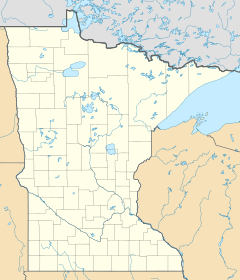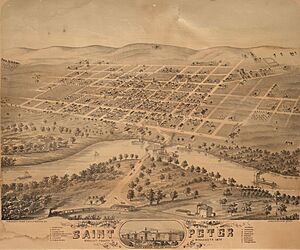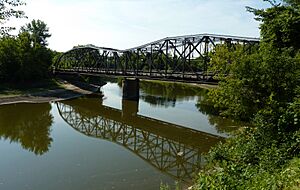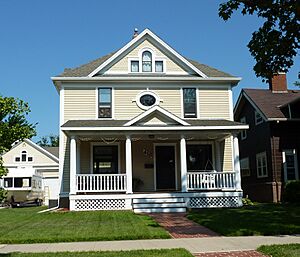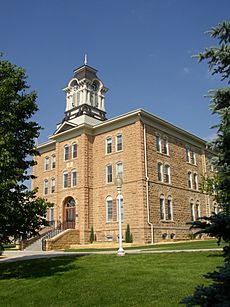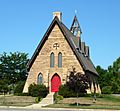St. Peter, Minnesota facts for kids
Quick facts for kids
St. Peter
|
|
|---|---|
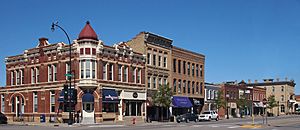
Downtown St. Peter
|
|
| Motto(s):
"Where History & Progress Meet"
|
|
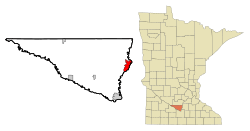
|
|
| Country | United States |
| State | Minnesota |
| County | Nicollet |
| Founded | 1853 |
| Incorporated | 1873 |
| Government | |
| • Type | Mayor – Council |
| Area | |
| • City | 6.24 sq mi (16.16 km2) |
| • Land | 6.06 sq mi (15.70 km2) |
| • Water | 0.17 sq mi (0.45 km2) |
| Elevation | 850 ft (260 m) |
| Population
(2020)
|
|
| • City | 12,066 |
| • Estimate
(2022)
|
12,156 |
| • Density | 1,989.78/sq mi (768.30/km2) |
| • Metro | 104,072 (US: 350th) |
| Time zone | UTC−6 (Central) |
| • Summer (DST) | UTC−5 (CDT) |
| ZIP Code |
56082
|
| Area code(s) | 507 |
| FIPS code | 27-58036 |
| GNIS feature ID | 2396517 |
St. Peter is a city in Nicollet County, Minnesota, United States. It is also the county seat, which means it's the main city where the county government is located. St. Peter is about 10 miles north of the Mankato – North Mankato metropolitan area.
In 2020, about 12,066 people lived in St. Peter. The city is home to Gustavus Adolphus College, a well-known school. Major roads like U.S. Highway 169 and Minnesota State Highways 22 and 99 run through the city. St. Peter also has a special connection with Petatlán, Guerrero, Mexico, which is its sister city.
Contents
Geography and Climate
How Big is St. Peter?
St. Peter covers an area of about 6.24 square miles (16.16 square kilometers). Most of this area, about 6.06 square miles (15.70 square kilometers), is land. The rest, about 0.17 square miles (0.45 square kilometers), is water.
What's the Weather Like in St. Peter?
St. Peter experiences a wide range of temperatures throughout the year. Summers are warm, while winters can be very cold with lots of snow. The city gets a good amount of rain, especially in the warmer months.
| Climate data for St. Peter, Minnesota, 1991–2020 normals, extremes 1893–present | |||||||||||||
|---|---|---|---|---|---|---|---|---|---|---|---|---|---|
| Month | Jan | Feb | Mar | Apr | May | Jun | Jul | Aug | Sep | Oct | Nov | Dec | Year |
| Record high °F (°C) | 65 (18) |
68 (20) |
92 (33) |
94 (34) |
107 (42) |
104 (40) |
109 (43) |
104 (40) |
103 (39) |
92 (33) |
81 (27) |
69 (21) |
109 (43) |
| Mean maximum °F (°C) | 42.8 (6.0) |
47.9 (8.8) |
65.4 (18.6) |
79.9 (26.6) |
88.9 (31.6) |
92.5 (33.6) |
93.1 (33.9) |
90.7 (32.6) |
88.7 (31.5) |
81.9 (27.7) |
63.9 (17.7) |
47.2 (8.4) |
95.5 (35.3) |
| Mean daily maximum °F (°C) | 21.9 (−5.6) |
26.7 (−2.9) |
39.9 (4.4) |
54.8 (12.7) |
67.8 (19.9) |
77.8 (25.4) |
81.9 (27.7) |
79.4 (26.3) |
72.2 (22.3) |
58.2 (14.6) |
41.8 (5.4) |
27.5 (−2.5) |
54.2 (12.3) |
| Daily mean °F (°C) | 12.5 (−10.8) |
16.8 (−8.4) |
30.3 (−0.9) |
43.9 (6.6) |
57.0 (13.9) |
67.4 (19.7) |
71.5 (21.9) |
69.1 (20.6) |
60.4 (15.8) |
46.8 (8.2) |
32.2 (0.1) |
19.2 (−7.1) |
43.9 (6.6) |
| Mean daily minimum °F (°C) | 3.1 (−16.1) |
6.9 (−13.9) |
20.6 (−6.3) |
32.9 (0.5) |
46.3 (7.9) |
57.0 (13.9) |
61.2 (16.2) |
58.8 (14.9) |
48.7 (9.3) |
35.4 (1.9) |
22.7 (−5.2) |
10.9 (−11.7) |
33.7 (1.0) |
| Mean minimum °F (°C) | −18.1 (−27.8) |
−11.4 (−24.1) |
−0.5 (−18.1) |
19.6 (−6.9) |
32.9 (0.5) |
44.8 (7.1) |
51.4 (10.8) |
48.3 (9.1) |
35.0 (1.7) |
22.3 (−5.4) |
7.3 (−13.7) |
−10.3 (−23.5) |
−19.9 (−28.8) |
| Record low °F (°C) | −40 (−40) |
−36 (−38) |
−30 (−34) |
−5 (−21) |
14 (−10) |
32 (0) |
34 (1) |
34 (1) |
21 (−6) |
4 (−16) |
−22 (−30) |
−32 (−36) |
−40 (−40) |
| Average precipitation inches (mm) | 0.96 (24) |
0.96 (24) |
1.79 (45) |
3.06 (78) |
4.04 (103) |
5.13 (130) |
4.41 (112) |
3.56 (90) |
3.16 (80) |
2.50 (64) |
1.68 (43) |
1.17 (30) |
32.42 (823) |
| Average snowfall inches (cm) | 8.8 (22) |
8.2 (21) |
4.2 (11) |
2.7 (6.9) |
0.0 (0.0) |
0.0 (0.0) |
0.0 (0.0) |
0.0 (0.0) |
0.0 (0.0) |
0.2 (0.51) |
3.2 (8.1) |
10.6 (27) |
37.9 (96.51) |
| Average precipitation days (≥ 0.01 in) | 5.0 | 4.3 | 5.9 | 8.2 | 10.2 | 10.6 | 8.9 | 8.0 | 7.0 | 6.8 | 4.7 | 5.3 | 84.9 |
| Average snowy days (≥ 0.1 in) | 4.3 | 3.1 | 1.5 | 0.6 | 0.0 | 0.0 | 0.0 | 0.0 | 0.0 | 0.1 | 1.7 | 3.5 | 14.8 |
| Source 1: NOAA | |||||||||||||
| Source 2: National Weather Service | |||||||||||||
People of St. Peter
How Many People Live Here?
The number of people living in St. Peter has grown steadily over the years.
| Historical population | |||
|---|---|---|---|
| Census | Pop. | %± | |
| 1870 | 2,124 | — | |
| 1880 | 3,436 | 61.8% | |
| 1890 | 3,671 | 6.8% | |
| 1900 | 4,302 | 17.2% | |
| 1910 | 4,176 | −2.9% | |
| 1920 | 4,335 | 3.8% | |
| 1930 | 4,811 | 11.0% | |
| 1940 | 5,870 | 22.0% | |
| 1950 | 7,754 | 32.1% | |
| 1960 | 8,484 | 9.4% | |
| 1970 | 8,339 | −1.7% | |
| 1980 | 9,056 | 8.6% | |
| 1990 | 9,421 | 4.0% | |
| 2000 | 9,747 | 3.5% | |
| 2010 | 11,196 | 14.9% | |
| 2020 | 12,066 | 7.8% | |
| 2022 (est.) | 12,156 | 8.6% | |
| U.S. Decennial Census 2020 Census |
|||
Who Lives in St. Peter?
In 2010, there were 11,196 people living in St. Peter. Most residents were White (90.1%). Other groups included African American (3.3%), Native American (0.6%), and Asian (1.6%). About 6.4% of the population was Hispanic or Latino.
The average age in the city was 27.5 years old. Many young people live here, especially those attending college. About 19.4% of residents were under 18, and 27.1% were between 18 and 24.
History of St. Peter
How St. Peter Began
St. Peter was founded in 1853 by Captain William Bigelow Dodd. He first called the settlement "Rock Bend" because of the rock formations along the Minnesota River. In 1855, a group of business people from St. Paul formed the Saint Peter Company and renamed the town St. Peter. The president of this company was Willis Gorman, who was the governor of the Minnesota Territory at the time. Many streets in St. Peter were named after streets in New York City.
St. Peter was an important location because it was on the Minnesota River. This river was a major path for boats, especially during the fur trade. A place called Traverse des Sioux, just north of St. Peter, was a key trading spot for Native Americans and later for fur traders. Larger steamships could travel up the river as far as Traverse des Sioux.
The Capital City That Wasn't
In 1857, there was an attempt to move the capital of the Minnesota Territory from St. Paul to St. Peter. St. Peter was seen as a more central and easier-to-reach location for lawmakers. A bill to make St. Peter the capital passed both parts of the government. However, a lawmaker named Joe Rolette hid the bill until the legislative session ended. This meant the bill could not be signed into law. Because of this, St. Paul remained the capital, and St. Peter stayed a smaller town.
Important Events and Treaties
In 1851, the Treaty of Traverse des Sioux was signed near St. Peter between the Sioux (Dakota) people and the U.S. Government. This treaty involved a large amount of land. However, promises made in the treaty were not kept. This led to the Dakota War of 1862. During this conflict, Captain William Bigelow Dodd, the founder of St. Peter, was killed while defending the town of New Ulm. He was later buried in St. Peter.
In 1866, the first "Minnesota Asylum for the Insane" was built in St. Peter. It is now known as the St. Peter Regional Treatment Center.
Governors from St. Peter
St. Peter is known for being the home of five Minnesota governors:
- Willis Arnold Gorman (Territorial Governor, 1853–1857)
- Henry Adoniram Swift (State Governor, 1863–1864)
- Horace Austin (State Governor, 1870–1874)
- Andrew Ryan McGill (State Governor, 1887–1889)
- John Albert Johnson (State Governor, 1905–1909)
The most famous of these is John Albert Johnson. He was born in St. Peter in 1861. He started working at a young age to help his family. He became the editor of the local newspaper, the St. Peter Herald. Later, he was elected to the state senate and then became Minnesota's 16th governor. He was reelected twice and was even considered a possible candidate for president. Sadly, he passed away in 1909 after an operation. His funeral in St. Peter was the largest the city had ever seen.
Mayors of St. Peter
Many people have served as mayor of St. Peter over the years. One notable mayor was Lillien M. (Cox) Gault-Wolfe, who served from 1921 to 1922. She was the first woman mayor in Minnesota.
- Eugene St. Julien Cox 1865–1867
- Francis E. Lange 1868–1869
- William Schimmell 1870–1872
- Albert Knight 1873–1875
- Addison L. Sackett 1876–1878
- Azro A. Stone 1879
- Philip Dick, Sr. 1880–1882
- Gustav W. Steinke 1883–1884
- Gideon S. Ives 1885
- Joseph A. Mason 1886–1888
- Philip Dick, Sr. 1889–1893
- Henry Moll 1894–1895
- Dr. Lewis M. Erickson 1896–1898
- Melville G. Hanscome 1899–1900
- William H. Mueller 1901–1905
- William H. Rounseville 1906
- Philip Dick, Sr. 1907–1909
- Edward Bornemann 1910–1912
- Philip E. Dick, Jr. 1913–1914
- Edward Bornemann 1915
- Adolph Bornemann 1916–1917
- William Haesecke 1918–1920
- Lillien M. (Cox) Gault-Wolfe 1921–1922
- Edward Woehler 1921–1930
- Dr. Arthur H. Bittner 1931–1933
- Floyd B. Johnson 1933–1935
- Otto T. Miller 1936–1937
- Reuben R. Seibert 1938–1940
- Otto T. Miller 1941–1942
- Henry B. Seitzer 1942–1943
- Andrew Cook 1944
- John R. Faust 1944–1946
- Henry E. Wiest 1946
- Clifford J. Nutter 1947–1948
- Elmer J. Kleifgen 1949–1951
- Prof. George W. Anderson 1951–1952
- Richard Konechne 1953–1956
- Leighton R. Swenson 1957–1958
- Mark W. Schaus 1959–1960
- George W. Martens 1960–1961
- Arthur W. Cook 1962–1963
- Lamar Hay 1964–1965
- George W. Martens 1966–1970
- Douglas C. Pyan 1971–1985
- William A. Wettergren 1986–1989
- Peter J. Rheaume 1990–1991
- Ellery O. Peterson 1992–1995
- Jerry K. Hawbaker 1996–2005
- Timothy J. Strand 2006–2015
- Chuck Zieman 2016–2021
- Shanon Nowell 2022–present
The 1998 Tornado
On March 29, 1998, a powerful tornado hit St. Peter. It caused a lot of damage to homes and buildings. Many houses and apartments were destroyed or seriously damaged. Important buildings like the Old Central School and parts of Gustavus Adolphus College were also affected.
Churches in St. Peter
St. Peter has many churches, reflecting its diverse community. Some of the churches include:
- Bethany Alliance Church (now Living Truth Fellowship)
- Calvary Baptist Church
- Church of St. Peter (Roman Catholic)
- Church of the Holy Communion (Episcopal)
- First Lutheran Church (ELCA)
- Good Samaritan United Methodist Church
- Sunrise Assembly of God
- St. Peter's Evangelical Lutheran Church (WELS)
- River of Life Lutheran Church (LCMS)
- Trinity Lutheran Church (ELCA)
- Union Presbyterian Church
- Christ Chapel (on the Gustavus Adolphus College campus)
Education in St. Peter
St. Peter is a great place for education. It is home to Gustavus Adolphus College, a private college connected with the Evangelical Lutheran Church in America.
For younger students, there is St. Peter High School. There are also private schools like John Ireland Catholic School (Kindergarten to 6th grade) and St. Peter Evangelical Lutheran School (Kindergarten to 8th grade). Veritas et Lux Preparatory School offers education from Kindergarten to 12th grade.
The first class graduated from St. Peter High School in 1880. An early superintendent of St. Peter Public Schools was Andrew Ryan McGill, who later became Minnesota's 10th governor.
Scholarship America, an organization that helps students get scholarships for college, is also based in St. Peter.
Healthcare Services
St. Peter provides several healthcare options for its residents. The main hospital is River's Edge Hospital, which used to be called St. Peter Community Hospital. Next to the hospital, there's River's Edge Clinic and the St. Peter Community Clinic, which is part of the Mayo Health System.
The Minnesota Security Hospital is also located in St. Peter. This facility helps people who have mental health conditions and need specialized care.
Other healthcare facilities include Benedictine Health Care Center and Pheasants' Ridge, which is an assisted living facility with special care for people with memory loss. Grandview Good Samaritan Center also provides healthcare services. In 2014, River Valley Birth Center opened, offering a new option for childbirth in the area.
Transportation in St. Peter
Getting around St. Peter is easy with several main roads. These include:
Famous People from St. Peter
Many interesting people have connections to St. Peter, including:
- Alice A. Andrews — a talented pianist and composer.
- Horace Austin — a former governor of Minnesota.
- Henry N. Benson — a Minnesota Attorney General.
- Herbert W. Chilstrom - a bishop in the Evangelical Lutheran Church of America.
- Eugene Saint Julien Cox — a mayor of St. Peter and judge.
- Anne Martell Denver — the wife of famous singer John Denver.
- Olive Fremstad — a well-known opera singer.
- Willis Arnold Gorman — a former governor of the Minnesota Territory.
- Paul Granlund — an American sculptor.
- James M. Hinds — a congressman.
- Gideon S. Ives — a former lieutenant governor of Minnesota and mayor of St. Peter.
- Carl M. Johnson — a politician and businessman.
- John Albert Johnson — a former governor of Minnesota and newspaper editor.
- Verne C. Johnson — a politician and lawyer.
- Andrew Ryan McGill — a former governor of Minnesota and newspaper editor.
- James M. McPherson — a historian who writes about the American Civil War.
- Steve Neils — a football player.
- Milt Nielsen — a baseball player.
- Allen Quist — a former state representative.
- Benjamin H. Randall — a politician.
- Rick Rude — a professional wrestler.
- Myer Skoog — known for inventing the jump shot in basketball.
- Doug Swenson — a politician, lawyer, and judge.
- Henry A. Swift — a former governor of Minnesota.
- John H. Tolan — a politician and lawyer.
- Thomas Smith Williamson — a doctor and missionary.
- Earl Witte — a football player.
Images for kids
-
The Church of the Holy Communion is one of several St. Peter structures on the National Register of Historic Places.
See also
 In Spanish: St. Peter (Minesota) para niños
In Spanish: St. Peter (Minesota) para niños


